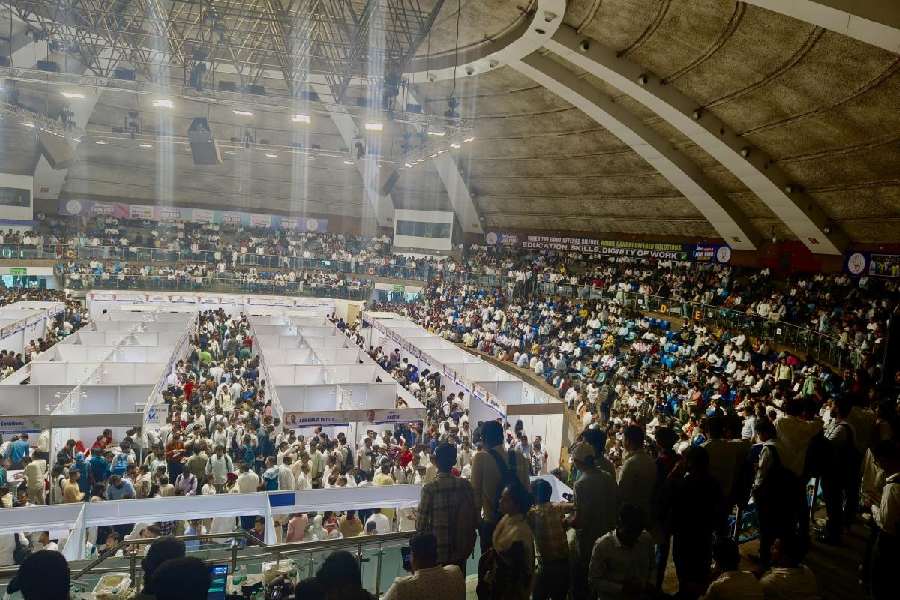 |
| Models present Sabyasachi creations at the fashion show on Monday. (AFP) |
New Delhi, April 25: Jassi has gone for a makeover but not Sabyasachi Mukherjee?s Plain Jane. The international market will decide how far she will go beyond Delhi.
The Calcutta designer raised quite a few eyebrows by parading a sober collection, titled Nair Sisters, that stood in sharp contrast to the opulent shows preceding his at India Fashion Week today.
The Plain Jane look of Mukherjee?s models came across directly through the trademark glasses and the dull palette, reminiscent of the designer?s passion for creating for the common woman.
?He hasn?t evolved at all? was the refrain from the audience but Mukherjee stood by his creations.
?The mood carries on from one year to the other, one cannot expect pockets of creative inspiration every season. Usually, a mood reflects in creations for two to three years before it dissolves,? he said.
The colour story, styling, texturisation and trademark techniques had the hallmark of some of the designer?s earlier works.
Oversized clothes ? shirts, skirts, jackets, tops, dresses, blouses ? often put together in one ensemble and in muted shades of dull green, dirty pink, brown, beige and khaki defined the look of the collection. A remixed version of Jawani Janeman introduced the retro mood of the 70s and 80s.
Though the deglamourised look caused quite a lot of disappointment, Mukherjee had his reasons. ?I?ll be showing this collection at Browns in London next and that?s what sells in the international market. I think this is my most commercial collection, where I have concentrated on the ease of production. It?s a transition from fall winter 2005 to spring summer 2006 and I have designed keeping the international forecasts in mind,? said the confident youngster.
Some in the audience did agree. ?The fabrics and colours Sabyasachi has used are very suited to the international market and that?s what matters from the commercial angle. We Indians like brighter hues, so we want to see a riot of colours on the ramp, but one has to understand the purpose,? said Divya Gurwara, the lady behind Bridal Asia.
The day of the bigwigs ? Tarun Tahiliani, Rohit Bal and Mukherjee ? started off with a debutant from Calcutta, Shantanu Goenka, making a mark with his collection called Krishna Couture.
Cows mooing in the background set the mood for the line plastered with digital prints of Lord Krishna on T-shirts, tops, kurtas and dresses.
A vibrant colour code ruled by violet, yellow, red and orange, theme accessories, make-up and music, and actor Riya Sen making a special appearance on the ramp worked wonders for Goenka, who was one of the few to receive a standing ovation.
The digital prints were visible all over the next show as well, put up by the pioneer of this technique in Indian fashion.
Tahiliani opted for a luxurious display of ensembles inspired by the Silk Route ? from Afghani and Bedouinesque, Indian and Moroccan, Turkish and Kurdish.
Delicious drops of Swarovski, pearls, emeralds, rubies and sapphires used in intricate patterns and yards of gold chains and ropes of crystals were combined with his digital prints to give them a three-dimensional effect.
The palette comprised pink, purple, green, olive and blue in fabrics like stretch chameuse, georgette, chiffon and stretch silk. The elegant dresses, gowns, kaftans, jewelled tees, pencil skirts, jackets, fitted shirts and suits were a fine presentation of retro inspiration on modern garments.
White has woven its magic in many a collection at the fashion week, but none with the sparkling effect that it had in the next line by a designer known for his trademark use of the colour. Full marks to Rohit Bal for the ambience, which was decidedly the best in the fashion week so far.
Drawn from the celebration of the first snowfall in Kashmir, called Sheen Mubarak, the collection, according to Bal, reflected ?purity of thought?. While the happy music lifted the mood almost at once, visual projections of snowfall on the walls all around throughout the show served as the perfect backdrop for the collection.
The free-flowing layered lehengas, skirts, jackets, coats, bustiers and sherwanis were adorned by the age-old Wark ka Kaam, real silver and gold leaf printing, with Mughal motifs revived by the designer.
Natural fabrics like muslin, silk chiffon, chanderi and matka silk shaped the garments in winter white. The revivalist line also saw the use of an old Mughal emblem found on jackets of the emperors during the 15th century.










